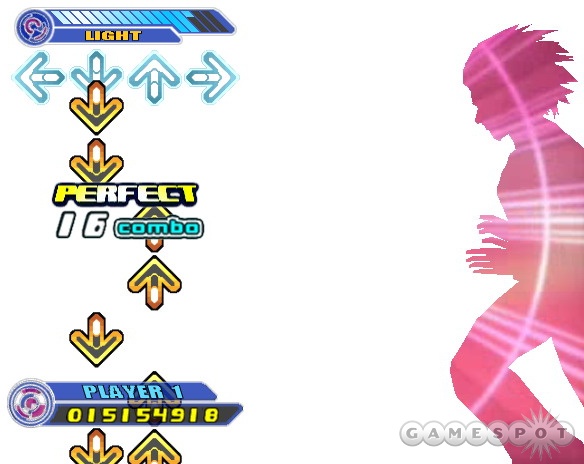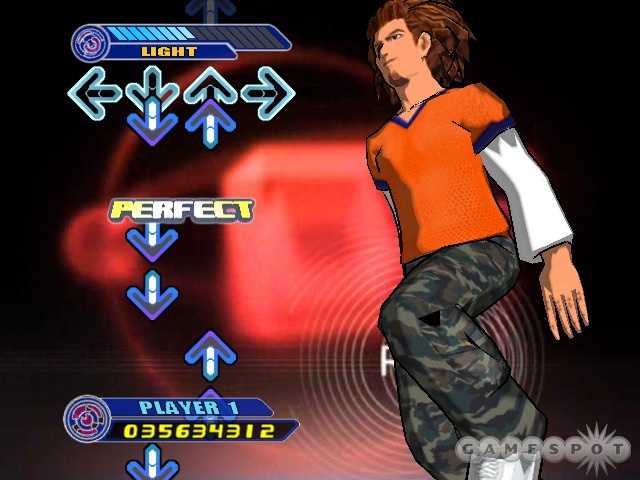Konami's rhythm-based Dance Dance Revolution series made its first appearance on the Xbox with last year's Ultramix, and it made a good first impression. Sporting all the standard modes DDR fans have come to expect, along with some clever new multiplayer modes, four-player support, and Xbox Live support for both competitive play and downloadable content, Ultramix was the most feature-rich DDR game to appear on any console. A year later we're treated to DDR Ultramix 2, which is almost identical to the first Ultramix. This might have been a big disappointment if this entry in the series wasn't still the best value to be found in a DDR game. Fortunately, Konami further sweetens the purchase deal by including an even larger track list.

Even if you don't know it by name, you've seen kids stomping wildly on Dance Dance Revolution machines in movie theater lobbies, at the mall, in bowling alleys, or perhaps even in honest-to-goodness arcades. Eschewing any sort of conventional control scheme, DDR demands that you follow onscreen commands that prompt you to step on a four-way directional pad in specific sequences and in time with the music that's playing. There have been many oddball strains of DDR over the years, but Ultramix 2 sticks to the basic four-panel control scheme. Bringing the experience home means that you'll need an Xbox-compatible dance pad controller to really experience Ultramix 2, since there's no point to DDR if you don't break a sweat.
And thanks to the difficulty level in Ultramix 2, you'll be pouring sweat after a few songs, even on the second-lowest difficulty level. Ultramix 2 is definitely designed for those who have put in serious work with past versions of the game, and it provides a hearty challenge from the get-go. It also gives you a good variety of gameplay modes to test your skills. You can go in to the main game mode for a straight-up song, which is about as vanilla as the gameplay gets in Ultramix 2. There are the other standards as well, such as the edit mode, which lets you compose your own step routines, and the workout mode, which ostensibly counts the calories you're burning as you play.
The unique modes introduced in Ultramix return in Ultramix 2 as well. There are the battle modes, which support between two and four players and rate you based on either your overall score or the accuracy of your steps. For crazier multiplayer action, there's the party mode, which comprises a suite of competitive gameplay modes with special conditions. Not missing steps in the attack mode will help you build up combos that will cause your opponent's step line to drop down on the screen, thus making it harder for him or her to anticipate what steps are coming next. The bomb mode is a hot-potato game where a bomb with a timer is dropped on a player, and he or she has to get a five-step combo before the timer runs out to effectively pass the bomb to the next player. The quad mode is actually a single-player game requiring you to dance on four dance mats configured in a giant square, which is utterly insane. The sync mode is actually cooperative in nature, and it requires all those who are participating to achieve a certain accuracy in their steps to let the group proceed.
The challenge mode is probably the single most unique and, well, challenging mode in Ultramix 2, simply because it requires a little more cerebral effort than the pure motor reflexes that DDR usually relies on. The challenges are broken up by skill level, and each skill level contains a set of challenges. These go from the simplest of not missing any steps for the duration of a song or achieving perfect accuracy on a certain percentage of your steps, and they go to the more difficult tasks of avoiding specially colored "poison" arrows or not stepping on any two arrows at the same time. Since high-level DDR play is all about quickly reacting to onscreen commands without thinking about it, these additional rules, which often contradict what your DDR instincts might tell you, present a real interesting change of pace.
The expanded Xbox Live support in Ultramix 2 represents one of the more significant changes Konami has made since last year. Originally, the live competition, which returns here, was limited to one-on-one matches. Ultramix 2 also allows for online tournaments, with up to 16 players, using a ladder-style structure to eliminate players through a series of one-on-one matches. The online tournaments are a good addition to the game's online package, and the inclusion of voice chat support ensures that you'll be able to let your opponents know just exactly how they were served...in your own words.
Ultramix 2 comes with 60 unique tracks out of the box, a large number of them pulled from past iterations of DDR. And if you have Xbox Live, there are even more songs that you can download for a price. Presently, there are four downloadable packs, each containing five songs, and each going for five bucks a pop. The only nonpremium download offered at the moment is a new set of challenges for the challenge mode, though Konami is promising character and step downloads as well.
As is the case with all Dance Dance Revolution games, the step patterns require such intense focus that the actual players are pretty much incapable of appreciating the pulsing, swirling backgrounds or the cel-shaded characters that keep Ultramix 2 from being mind-numbingly boring to watch for onlookers. Though the dancers are cel-shaded, half the time they're displayed with such a multitude of strange filter effects that it's difficult to tell, though this isn't really a bad thing. Visually, the whole package is extremely flashy--from the background action during the game to the stylized, kinetic look of the menus--and it syncs up with the game's musical flavor almost perfectly.

Hyperenergized techno and disconcertingly sunny, sugary J-pop have been the staple genres for Dance Dance Revolution since the beginning, and both are represented fully in Ultramix 2. There's a handful of licensed tracks as well, such as the Commodore's "Brick House" and a Paul Oakenfold remix of Elvis Presley's "Rubberneckin'," but these are in the minority. So if synth-driven dance music doesn't get you going, then you'll have a bit of trouble finding music in Ultramix 2 that suits you.
Even though the game feels awfully similar to last year's Xbox game, Ultramix 2 is still a fantastic package, although it's just a little less impressive this time around. Owners of Ultramix will probably want to seriously appraise the song listing in Ultramix 2 before plunking down 50 bucks. Otherwise, Xbox owners looking for a solid rendition of a familiar rhythm action favorite can't go wrong with DDR Ultramix 2.